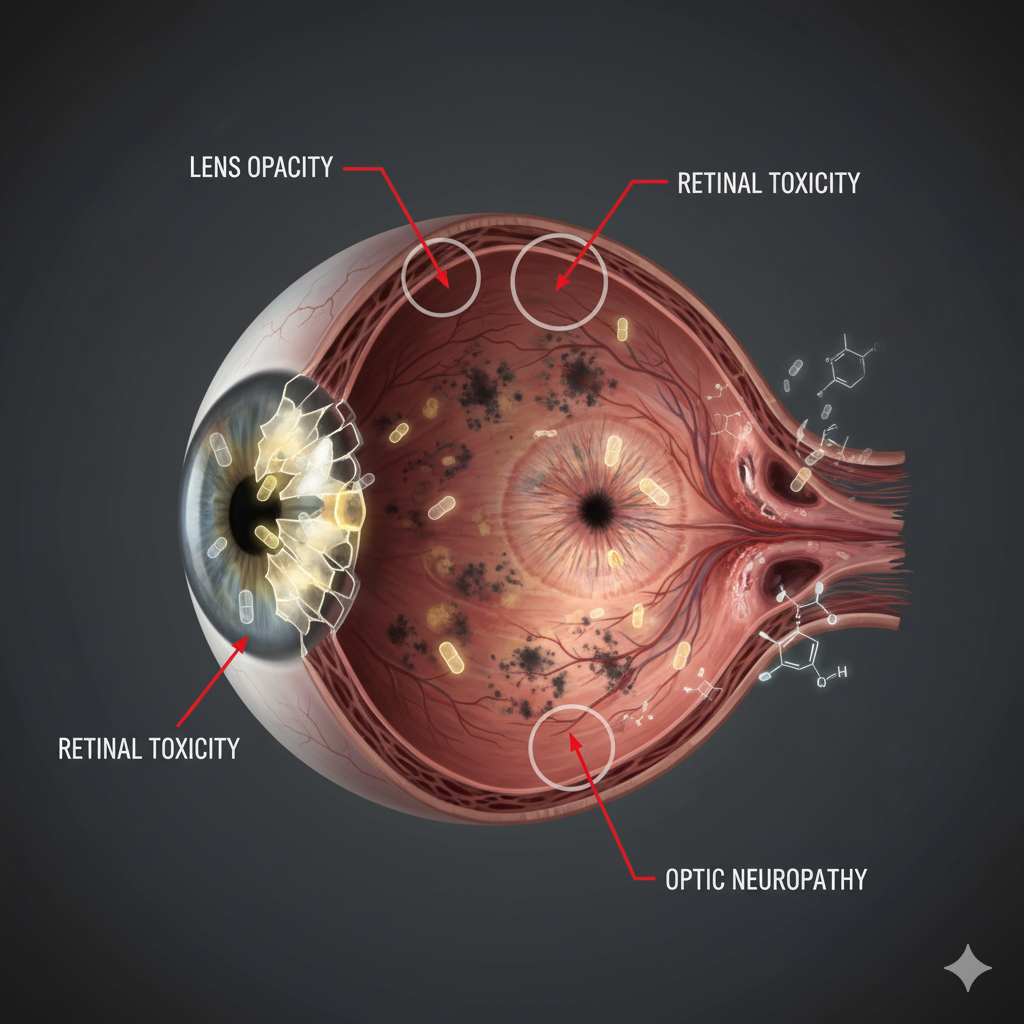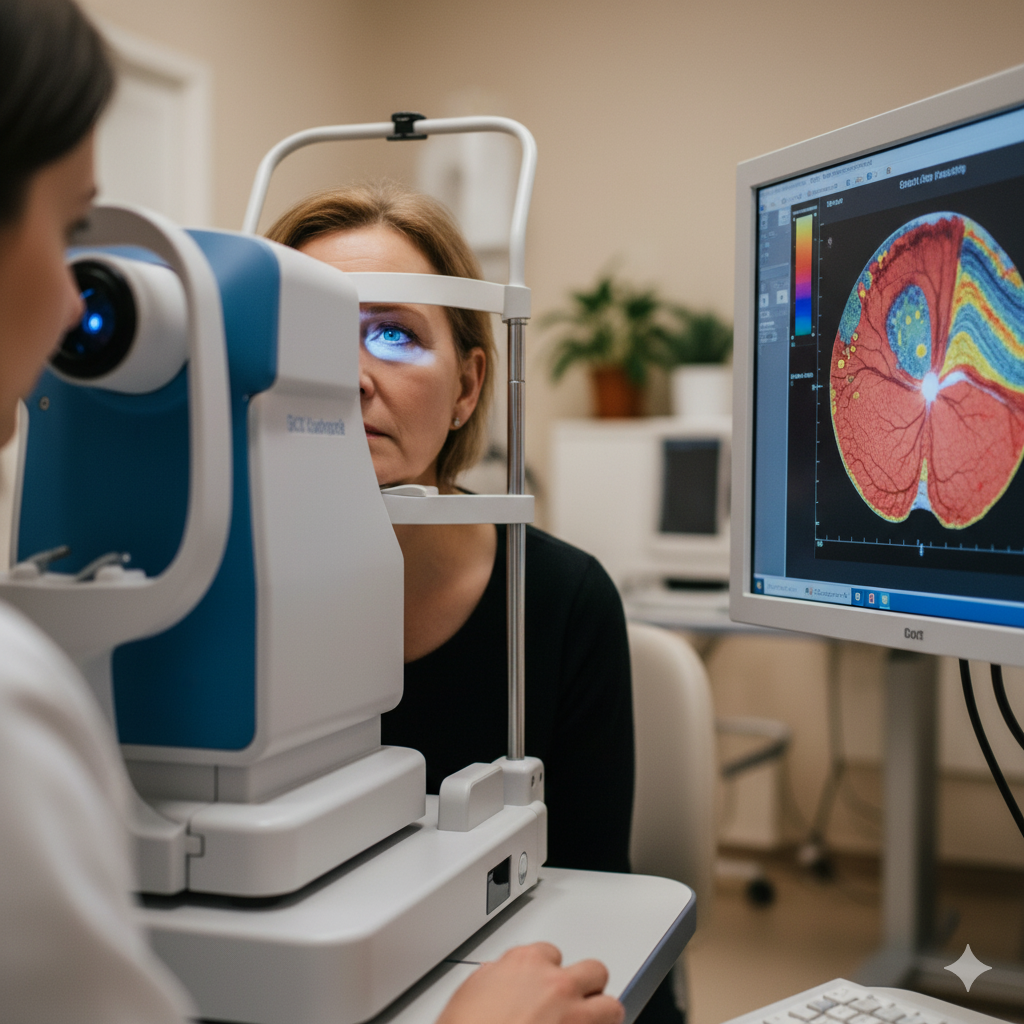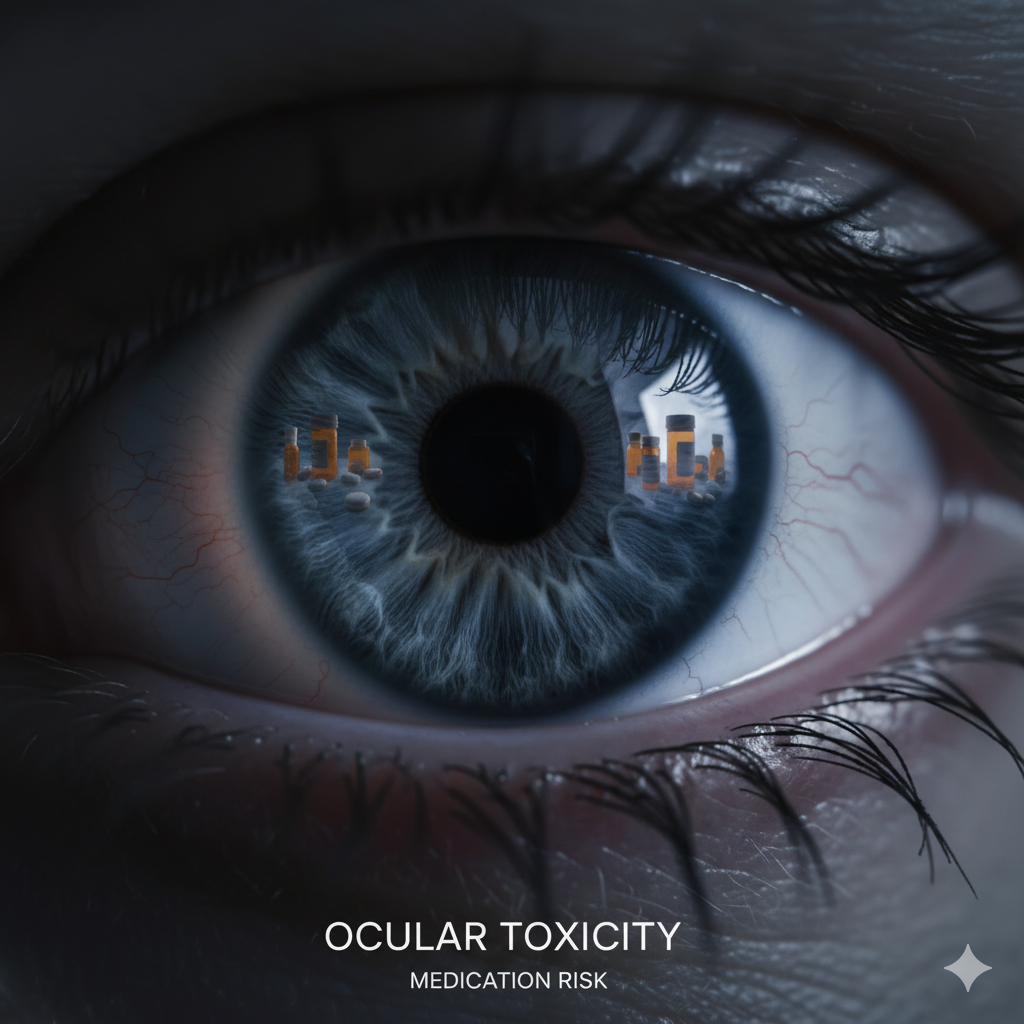Understanding Medication Side Effects Eyes is an essential part of modern preventative healthcare. Systemic medications, necessary for managing chronic conditions, can sometimes produce silent, yet catastrophic, effects on vision. This is due to the unique vulnerability of specialized eye tissue and the ability of certain compounds to cross the Blood-Retinal Barrier (BRB).Define the scope of ocular drug toxicity. Explain that systemic medications, necessary for managing chronic conditions, can sometimes produce silent, yet catastrophic, effects on vision. Introduce the concept of the Blood-Retinal Barrier (BRB) and why specialized eye tissue is vulnerable. State the article’s purpose: to empower patients and providers with knowledge of high-risk drugs and mandatory monitoring protocols.
1. The Ocular Pharmacology of Toxicity: How Drugs Impact Vision
This section details the biological mechanisms that allow systemic drugs to damage specific parts of the eye.
The Blood-Retinal Barrier (BRB): A Crucial Defense
- Detailed explanation of the BRB structure (tight junctions) and how lipophilic drugs can circumvent this defense, accumulating in the retina and optic nerve.
Mechanisms of Damage: Retinopathy, Optic Neuropathy, and Lens Opacity
- Categorize the types of drug damage: Retinopathy (e.g., Macular Edema), Optic Neuropathy (drug-induced blindness), and Cataractogenesis (lens clouding). Provide cellular-level details on mitochondrial dysfunction and photo-toxicity.

2. High-Risk Drug Classes and Their Specific Ocular Complications
This is the largest, most crucial clinical section, covering drug-specific monitoring requirements.
Antimalarials (Hydroxychloroquine/Plaquenil and Chloroquine)
- Detailed focus on Bull’s Eye Maculopathy. Discuss risk factors (cumulative dose, duration, renal function). Mandatory screening guidelines (2016 AAO recommendations: OCT, Visual Fields). [Focus Keyword: Medication Side Effects Eyes]
Did You Know?
The risk of Hydroxychloroquine (Plaquenil) toxicity rises sharply after 5 years of use, specifically when the cumulative dose exceeds 1,000 grams. Once vision loss occurs due to Plaquenil retinopathy, it is often irreversible, making annual screening tests (OCT and Visual Fields) mandatory for long-term users, even if they show no symptoms.
Corticosteroids (Prednisone, Dexamethasone)
- Discuss Steroid-Induced Glaucoma (IOP elevation) and Posterior Subcapsular Cataracts. Explain the difference between topical and systemic steroid risk.
Cardiovascular Drugs (Amiodarone)
- Focus on Vortex Keratopathy (Corneal deposits—usually reversible) and the risk of Optic Neuropathy (irreversible). Importance of slit-lamp examination.
Antidepressants and Anxiolytics
- Discuss risk of Acute Angle-Closure Glaucoma (especially with SSRIs/SNRIs) due to pupil dilation (mydriasis). Importance of baseline anterior chamber depth check.
Erectile Dysfunction (ED) Drugs (Sildenafil/Viagra, Tadalafil/Cialis)
- Detail the common, transient effect of Blue Tinge Vision and the severe, rare risk of Non-Arteritic Anterior Ischemic Optic Neuropathy (NAION).
Cancer Treatments (Tamoxifen, Chemotherapy, Immunotherapy)
- Focus on Tamoxifen Retinopathy and the high risk of severe Dry Eye Syndrome and secondary infections related to systemic immunosuppression.
Dermatological Agents (Isotretinoin/Accutane)
- Detail severe Drug-Induced Dry Eye (gland damage) and risk of Pseudotumor Cerebri (Intracranial Hypertension).
3. Prevention and Monitoring Protocols (Saving Your Sight)
This section provides the actionable framework for proactive care.
The Importance of Baseline Ophthalmic Exams
- Discuss why a comprehensive exam before starting high-risk medication is the single most critical step. Detailed patient history documentation.
Advanced Imaging: OCT and Visual Fields
- Explain how non-invasive tests like Optical Coherence Tomography (OCT) and Visual Field Testing detect subclinical damage long before the patient notices symptoms. Specific examples using Plaquenil screening.

4. Drug-Induced Ocular Surface Disease (Dry Eye and Conjunctivitis)
Addressing the most common, yet often dismissed, side effect.
The Role of Antihistamines and Decongestants
- How over-the-counter (OTC) drugs impact tear film production and lead to chronic dry eye. The vicious cycle of red eye drops.
Managing Severe Drug-Related Dry Eye (Beyond Tears)
- Advanced treatments: Cyclosporine, Lifitegrast, Autologous Serum, and Punctal Plugs. Connect this to the MGD Protocol (Internal Link).
5. Vision Biohacking and Detoxification Support
Nutritional Support (Vitamins and Antioxidants) to Mitigate Damage
- Discuss the protective role of Macular Pigments (Lutein, Zeaxanthin) and Omega-3s in supporting retinal health against toxic load.
Lifestyle Optimization for High-Risk Patients
- Stress reduction, sleep hygiene, and managing systemic inflammation to reduce ocular vulnerability.
❓ Frequently Asked Questions (FAQ)
1. Is the vision damage caused by high-risk medications reversible?
Answer: The reversibility of damage depends entirely on the drug and the ocular structure affected. Drug-induced retinopathies (e.g., from Plaquenil) and optic nerve damage (e.g., from Amiodarone) are often irreversible once symptomatic vision loss occurs. However, conditions like steroid-induced glaucoma or drug-related corneal changes (e.g., Vortex Keratopathy) may be partially or fully reversible once the medication is stopped or the dose is reduced. This highlights why strict, mandatory monitoring is essential.
2. How often should I be screened if I take Hydroxychloroquine (Plaquenil)?
Answer: The current standard of care mandates a baseline ophthalmic exam before starting Plaquenil. Monitoring should then begin annually after 5 years of use, or sooner if there are significant risk factors (e.g., high daily dose, kidney disease, or pre-existing macular disease). Annual screening must include advanced imaging techniques like Optical Coherence Tomography (OCT) and Visual Field testing.
3. Can steroid eye drops cause Glaucoma?
Answer: Yes. Both systemic (oral) and topical (eye drops) corticosteroids can significantly increase intraocular pressure (IOP), leading to a condition known as Steroid-Induced Glaucoma. This risk is higher for certain individuals (called “steroid responders”). If you use steroid drops for more than two weeks, your eye doctor must monitor your IOP frequently.
4. What are the most common over-the-counter (OTC) drugs that cause dry eye?
Answer: The most common OTC culprits for exacerbating or causing dry eye are oral antihistamines, decongestants, and certain sleep aids (due to anticholinergic effects). These drugs decrease overall tear production and reduce the quality of the tear film, often leading to chronic irritation, grittiness, and redness.
5. What vision symptoms require an emergency visit to the eye doctor?
Answer: Seek immediate medical attention if you experience:
- Sudden, painless loss of vision in one or both eyes (potential NAION, Retinal Vein Occlusion).
- Acute onset of eye pain accompanied by nausea, vomiting, or blurred vision (potential Acute Angle-Closure Glaucoma).
- Sudden onset of flashes, floaters, or a curtain obscuring your vision (potential Retinal Detachment).
- Sudden development of persistent blue or yellow tinting of your vision (especially after taking ED drugs).
6. I’m starting a new high-risk medication. What is the single most important step I should take?
Answer: The most critical step is to schedule a Baseline Ophthalmic Exam before you take the first dose. This establishes a clear photographic record of your retina and optic nerve (via OCT) while your eyes are healthy. This baseline is essential for future comparison, allowing the doctor to detect subtle, drug-induced changes long before they cause noticeable vision loss.
Conclusion: Collaborative Care for Lifelong Vision Health
Summarize the main message: ocular drug toxicity is a serious but manageable risk. Emphasize the necessity of collaborative care between the prescribing physician and the ophthalmologist. Call to action: Consult your eye doctor immediately if starting a new medication.



